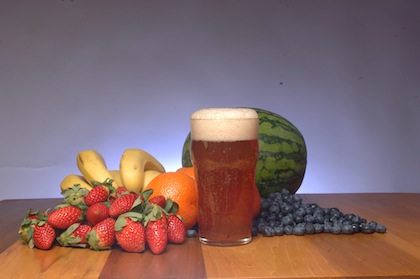The United States Department of Agriculture’s food pyramid suggests that we all consume two to four servings of fruit daily. I’m relatively certain that fruit beers don’t qualify, but with a wonderful fruity lambic or wheat beer in hand, one can dream.
Raspberry and cherry brews are almost commonplace and brewers making fruit beers are no longer unique.
Fruit beer is the invention of Belgian brewers. When you stop to think about it, the fact that brewers from the tiny country of Belgium—located right next door to the Reinheitsgebot constrained Germans—came up with the idea of marrying beer with fruit is as amazing as the taste of some of these brews.

(Kinsley Dey)
The classic Belgian kriek and framboise brews are something most beer lovers have tried, and now the use of cherries and raspberries has spread to brewers in this country. If you are lucky enough to live in the upper Midwest or committed enough to stand in the long line at the Great American Beer Festival (GABF), you can taste the award-winning New Glarus Raspberry Tart or Wisconsin Belgian Red (cherry), recognized by many to be among the best fruit brews in the country. Special releases from craft brewers like Samuel Adams, Widmer, New Holland and New Belgium also use these two classic brewing fruits.
But now cherry and raspberry brews are almost commonplace and brewers making fruit beers are no longer unique—the fruit beer category was one of the fastest growing at the 2009 GABF. The next frontier for fruit beers comes as a virtual orchard of other beers are emerging. Blueberry, apple, pear, peach and even banana are being used to make what just might be “Your Next Beer.”
There are fruit beers out there that I enjoy, but you can really only drink one of them,” says Nico Freccia, founder of 21st Amendment Brewery in San Francisco. A watermelon in Freccia’s kitchen a decade ago sparked an idea that resulted in a brew that Freccia calls “a beer first” and not a gimmick.
Hell or High Watermelon is always the top-selling summer beer in our pub,” Freccia says. “We put it in cans because it is the perfect beer to take to a barbecue, the beach or on a picnic.” Even though he doesn’t think of it as a fruit beer, about 400 pounds of watermelon go into making a 12-barrel batch of the wheat beer. Gone are the days when staff at 21st Amendment would carve up 40 cases of fresh watermelon to add to the beer. Now the brewery uses a slurry made by a juice company. The brewery cans Hell or High Watermelon Wheat in Minnesota and has distribution from Seattle to Northern California and from Massachusetts to Northern Virginia.
At RJ Rockers Brewing Co. in Spartanburg, SC, the idea for a fruit beer sprang from the staff’s desire to make a seasonal beer style that they had never tried before.
The peach is the state fruit of South Carolina, which we got pretty excited about,” said Case Wood, RJ Rockers’ sales director. The brewery uses a pound of pureed peaches from nearby Cooley Farms per every barrel of its Son of a Peach spring/summer seasonal.
We thought it would attract the attention of some consumers in the southeast because of the peaches and we also thought it might turn out to be a ‘chick beer.’ But we’ve been surprised because some of the biggest beer enthusiasts have really found something they like in this beer,” Wood says. RJ Rockers does not filter the brew, so the color is influenced by small peach particles that end up in the beer.
Alan Pugsley of Sea Dog Brewing Co. in Maine says Sea Dog Bluepaw Wild Blueberry Wheat Ale attracts a different beer drinker than the parent Shipyard Brewing’s Old Thumper Extra Special Ale. “Fans of Bluepaw are pretty evenly split between men and women. The beer is very easy to drink, refreshing and not overly bitter,” Pugsley says. The target market is different than the average hophead.
Sea Dog starting making Bluepaw in 2000 using an extract from wild Maine blueberries—the company added a raspberry beer in 2002 and apricot in 2006. The blueberry flavor is by far the best seller and has helped the brewery expand distribution.
Pugsley says the key to making a great fruit beer is in “achieving balance between the malt, hops and fruit. It’s important to find the right raw material. The sweetness and tartness of the fruit plays off the base brew.” Sea Dog’s brewers tweak the wheat beer recipe slightly for each of the three varieties.
Fruit beers are attracting new people to craft beer, including wine drinkers, Pugsley believes. The extreme beer movement has made beer drinkers more willing to experiment, meaning that just about any fruit or vegetable is a potential brewing ingredient.
Nothing is off limits,” Pugsley says. “I guess you could put cauliflower in there if you’d like.”
I’m not sure my taste buds are willing to go that far, but having tried beers with everything from coconut to pineapple flavors it’s almost certain that new flavors await. “Your Next Beer” just might be made from something that you would normally associate with a fruit salad.









